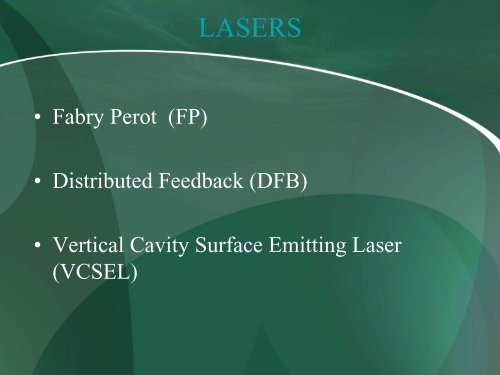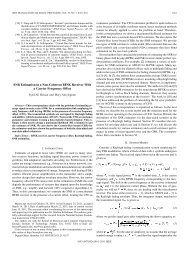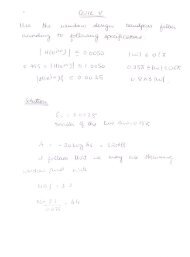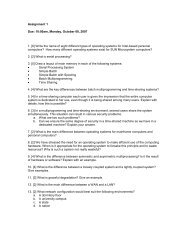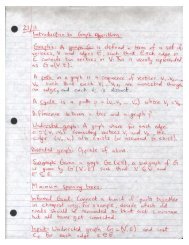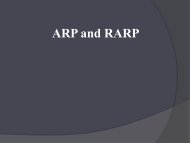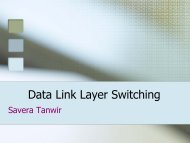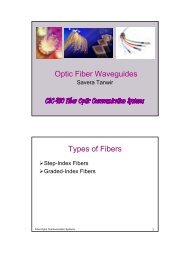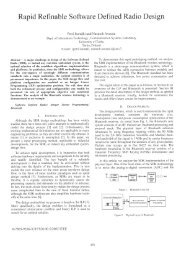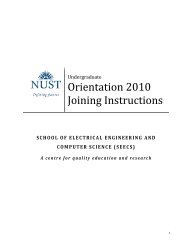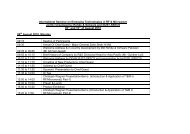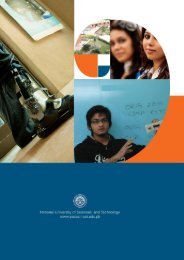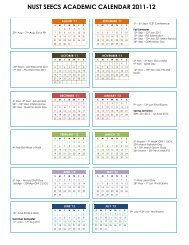Lec-6 Optsim(Fawad)(5-04-2007).pdf - Dr. SMH Zaidi - Home Page
Lec-6 Optsim(Fawad)(5-04-2007).pdf - Dr. SMH Zaidi - Home Page
Lec-6 Optsim(Fawad)(5-04-2007).pdf - Dr. SMH Zaidi - Home Page
You also want an ePaper? Increase the reach of your titles
YUMPU automatically turns print PDFs into web optimized ePapers that Google loves.
Peak Freq.• Peak Frequency = 229.644 THz [1310nm]• It can be inferred from the spectrum that spectralwidth of a FP is quite broad [~1.7 THz]
DFBSourceOpticalProbe
Peak Freq.• Peak Frequency = 228.879 THz [1310 nm]• Line width of a DFB Laser is narrower[~0.07THz]as compared to FP Laser which makes itsuitable for long haul communications
VCSELSourceOpticalProbe
Peak Freq.• Peak Frequency = 370.114 THz• Line width of a VCSEL is better than the two.[~0.<strong>04</strong> THz] Because of low power it is suitable forshort haul communications
<strong>Optsim</strong>Presented by: <strong>Fawad</strong> Khan
What is <strong>Optsim</strong>?
<strong>Optsim</strong> Simulation SoftwareUsed to design and optimize:- DWDM and CWDM amplifiedsystems- FTTX/PON systems- OTDM systems- CATV digital/analog systems- Optical LANs- Ultra long-haul terrestrial andsubmarine systems
Motivation• Since mid-90’s, computer simulations have beenused to realistically model optical communicationsystems• Computer-aided design techniques if usedappropriately1. optimize entire system2. provide optimum values of system parameters3. Design goals are met with minimal time and cost• Commercially available design software packages- Optiwave, VPITransmission Maker, Optnet,ZeMax
<strong>Optsim</strong> Methodology• <strong>Optsim</strong> uses block-orientatedsimulation methodology in whicheach block models a component orsubsystem• Each block model is presentedgraphically as an icon, has own set ofparameters which can be modified byuser
Simulation Approaches<strong>Optsim</strong> supports two simulationengines:1. Block mode simulation engine: signaldata is represented as one block ofdata and is passed between block toblock2. Sample mode simulation engine:signal data is represented as singlesample that is passed between blockto block
2 Simulation Modes
Simulation StepsFive steps to setting up a simulation ofa communication system:1. Create <strong>Optsim</strong> project and setsimulation parameters (Block modeVs Sample mode)2. <strong>Dr</strong>aw the schematic diagram3. Set parameter values of blockmodels4. Run simulation5. View results with data display tools
Modeling Stages• Stage 1: General Model (Modelingpreliminaries)• Stage 2: Select optimum parameters(Performance Evaluation)• Stage 3: See results after simulation(<strong>Optsim</strong> Validation)
Stage 1 - General Model• Design of optical communicationsystems involves optimizing a largenumber of parameters such as:• Transmitters, optical fibers,amplifiers, receivers• MUX/DEMUX, optical filters,• Optical cross connects, optical adddrop multiplexers etc
Stage 2 - Select Optimum Parameters• We need to know what type of noise is present andhow to eliminate or reduce its impact• BetterSNR (BER) should be accomplished• Attenuation minima at 1550nm• Transmitter noise could be handled by using filters• Quantum noise in case of photodiodes
Running the Simulation
Stage 3 - <strong>Optsim</strong> Validation• OptSim features performance analysis:• For example Q value• BER (Bit error rate)• Eye opening/closure• Spectrum Analyzer• Signal Analyzer• MultimeterAnalysis Tools
Case Study
<strong>Optsim</strong> View Layouts
Case Study• Take the example of a simpletransmission system with followingspecs:– Tx (Laser)– Modulator– Transmission Media (Fiber)– Rx (Photodiode)– Performance Analyzer Tool (BER Tester)
Step 1:Create Project in Block Mode
Step 2: Design Model/Schematic
Components• PRBS Generator• Electrical Generator• CW Laser• External Modulator• Fiber• ReceiverPlotting Components• BER Tester
Step 3: Select Parameters• Laser– Output Power = 4.7 dBm (Approx)– Wavelength = 1480 nm– Linewidth = 0.1nm• Fiber– Length = 10Km– Loss / km = 0.25 dB• Receiver– Quantum Efficiency = 0.85
Step 4: Run the Simulation
Step 5: View Results/ValidateRUN# BER BER_lo BER_hi1 8.8266e-055 1.2298e-059 3.8846e-050After viewing the output using BER Tester we found out that8.826e-55 is very good result
Thank You!


